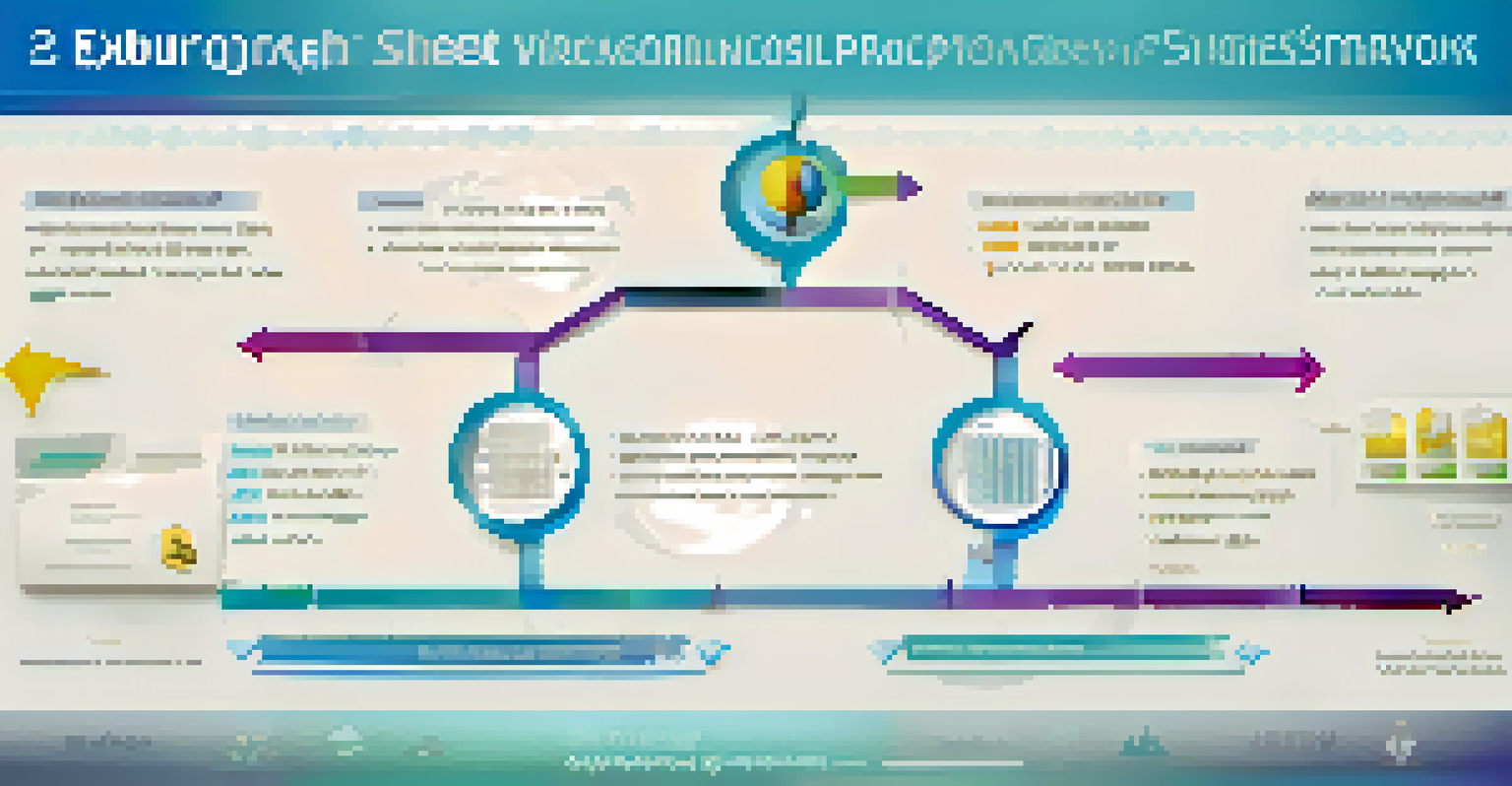Comparative Analysis of Ethereum Governance Frameworks

Understanding Governance in Ethereum
Governance in Ethereum refers to the processes and systems by which decisions are made about the protocol's development and evolution. Unlike traditional organizations, Ethereum's governance is decentralized, meaning that power is distributed among its community members rather than concentrated in a single entity. This approach allows for a diverse range of opinions and ideas to influence the platform's growth, fostering innovation and adaptability.
Decentralization is the key to ensuring that no single entity can dictate the future of Ethereum.
The importance of governance cannot be overstated; it ensures that the network can respond to challenges, implement upgrades, and maintain security. For instance, when critical issues arise, such as scalability concerns or security vulnerabilities, the governance framework plays a pivotal role in determining the best course of action. This decentralized decision-making process reflects a community-driven ethos that is fundamental to Ethereum’s identity.
Ethereum's governance is also shaped by its unique ecosystem, which includes developers, miners, and users. Each group has different stakes and perspectives, leading to a rich dialogue about the future of the network. This interplay between various stakeholders is essential for maintaining a balance between innovation and stability, ultimately guiding Ethereum towards a sustainable future.
The Role of Ethereum Improvement Proposals (EIPs)
Ethereum Improvement Proposals (EIPs) are critical to the governance framework, serving as a formalized way for developers to propose changes or enhancements to the network. Each EIP undergoes a rigorous review process, where community members can discuss, critique, and refine the proposal before it is considered for implementation. This structured approach helps ensure that only well-considered changes are made to the protocol.

EIPs also promote transparency in the decision-making process, allowing the broader Ethereum community to stay informed and engaged with ongoing developments. For example, the widely-discussed EIP-1559 aimed to improve transaction fee mechanisms and was met with significant community discourse before its eventual implementation. This level of engagement illustrates the democratic nature of Ethereum's governance.
Decentralized Governance is Key
Ethereum's decentralized governance allows community members to influence protocol development, ensuring diverse perspectives drive innovation.
Moreover, the EIP process encourages collaboration between developers and users, creating an environment where feedback can lead to better solutions. By nurturing an open dialogue, the Ethereum community can adapt to emerging trends and challenges, ensuring that the network remains robust and responsive to its users' needs.
On-Chain vs. Off-Chain Governance Models
Ethereum governance can be broadly categorized into on-chain and off-chain models. On-chain governance involves mechanisms built directly into the blockchain, allowing stakeholders to vote on proposals and changes in a transparent manner. This method promotes immediate participation, as decisions are made through smart contracts, and the results are automatically enforced by the network.
Governance is not about making the decisions, it's about how to make the decisions.
In contrast, off-chain governance relies on discussions, forums, and social media to reach consensus. This model allows for more nuanced debates and the consideration of complex issues that may not be easily quantified. However, it can sometimes lead to slower decision-making processes and may exclude those who are less active in community discussions.
Both models have their strengths and weaknesses, and the choice between them often depends on the nature of the proposal at hand. For example, technical upgrades may benefit from the efficiency of on-chain governance, while broader community initiatives might require the deliberative nature of off-chain discussions. Understanding these distinctions is key to navigating the governance landscape of Ethereum.
The Impact of Stakeholder Diversity on Governance
One of the defining characteristics of Ethereum's governance framework is its diversity of stakeholders. This includes developers, miners, investors, and everyday users, each bringing unique perspectives and interests to the table. This diversity can lead to richer discussions and more innovative solutions, but it can also result in conflicting priorities and disagreements.
For instance, miners may prioritize network security and transaction fees, while developers may focus on implementing new features and improving user experience. This tension highlights the challenge of reaching consensus and balancing competing interests within the governance process. Nonetheless, this dynamic can foster creativity and push the boundaries of what's possible within the Ethereum ecosystem.
EIPs Foster Community Engagement
Ethereum Improvement Proposals (EIPs) facilitate structured discussions and transparency, allowing developers and users to collaboratively shape the network.
Moreover, the active participation of various stakeholders ensures that governance is not dominated by a single group, promoting a more equitable and representative decision-making process. Engaging a broad spectrum of voices helps Ethereum adapt to the ever-changing landscape of technology and user needs, ultimately strengthening the network's resilience.
Case Studies: Successful Governance Decisions
Examining past governance decisions can provide valuable insights into what works within Ethereum's framework. One notable example is the transition from Ethereum’s original proof-of-work consensus mechanism to proof-of-stake, known as Ethereum 2.0. This ambitious upgrade was the result of extensive community engagement and deliberation, showcasing the effectiveness of the governance model in addressing significant challenges.
Another example is the implementation of EIP-1559, which revolutionized Ethereum's transaction fee structure. This proposal sparked widespread debate and ultimately garnered strong community support, leading to its successful implementation. The process illustrated how collaborative governance can lead to impactful changes that benefit the entire ecosystem.
These case studies highlight the importance of adaptability and responsiveness in Ethereum's governance. By learning from both successes and setbacks, the community can refine its processes and ensure that future decisions are informed by past experiences, fostering a culture of continuous improvement.
Challenges Facing Ethereum Governance
Despite its strengths, Ethereum's governance framework faces several challenges that could impact its future. One significant issue is the potential for centralization, where a small group of influential stakeholders could dominate decision-making processes. This scenario could undermine the decentralized ethos of Ethereum and alienate other community members, leading to fragmentation.
Additionally, the rapid pace of technological change in the blockchain space can create difficulties in keeping governance processes up to date. As new ideas and innovations emerge, existing governance structures may struggle to adapt, potentially leading to outdated practices. This highlights the need for ongoing evaluation and adjustment of governance models to remain effective.
Diverse Stakeholders Shape Decisions
The variety of stakeholders in Ethereum governance, including developers, miners, and users, enriches discussions but also presents challenges in reaching consensus.
Lastly, managing community consensus can be a daunting task, especially when opinions diverge widely on critical issues. Striking a balance between diverse viewpoints while ensuring timely decision-making is a delicate challenge that requires ongoing dialogue and compromise. Addressing these challenges is vital for the sustainability and growth of Ethereum's governance framework.
The Future of Ethereum Governance
Looking ahead, the future of Ethereum governance is likely to evolve as the ecosystem matures. As the community grows, we may see the emergence of new governance models that incorporate lessons learned from past experiences. Innovations such as decentralized autonomous organizations (DAOs) might play a role in shaping governance, allowing for even more democratic participation.
Moreover, the integration of new technologies, such as layer-2 scaling solutions, could influence governance frameworks by introducing novel methods for decision-making and implementation. These technologies may enhance user participation and improve the overall efficiency of governance processes, ensuring that Ethereum remains agile in a rapidly changing landscape.

Ultimately, the future of Ethereum's governance will be defined by its community's ability to adapt to challenges and capitalize on opportunities. By maintaining an open and inclusive dialogue, Ethereum can continue to thrive as a decentralized platform, fostering innovation while staying true to its core values.